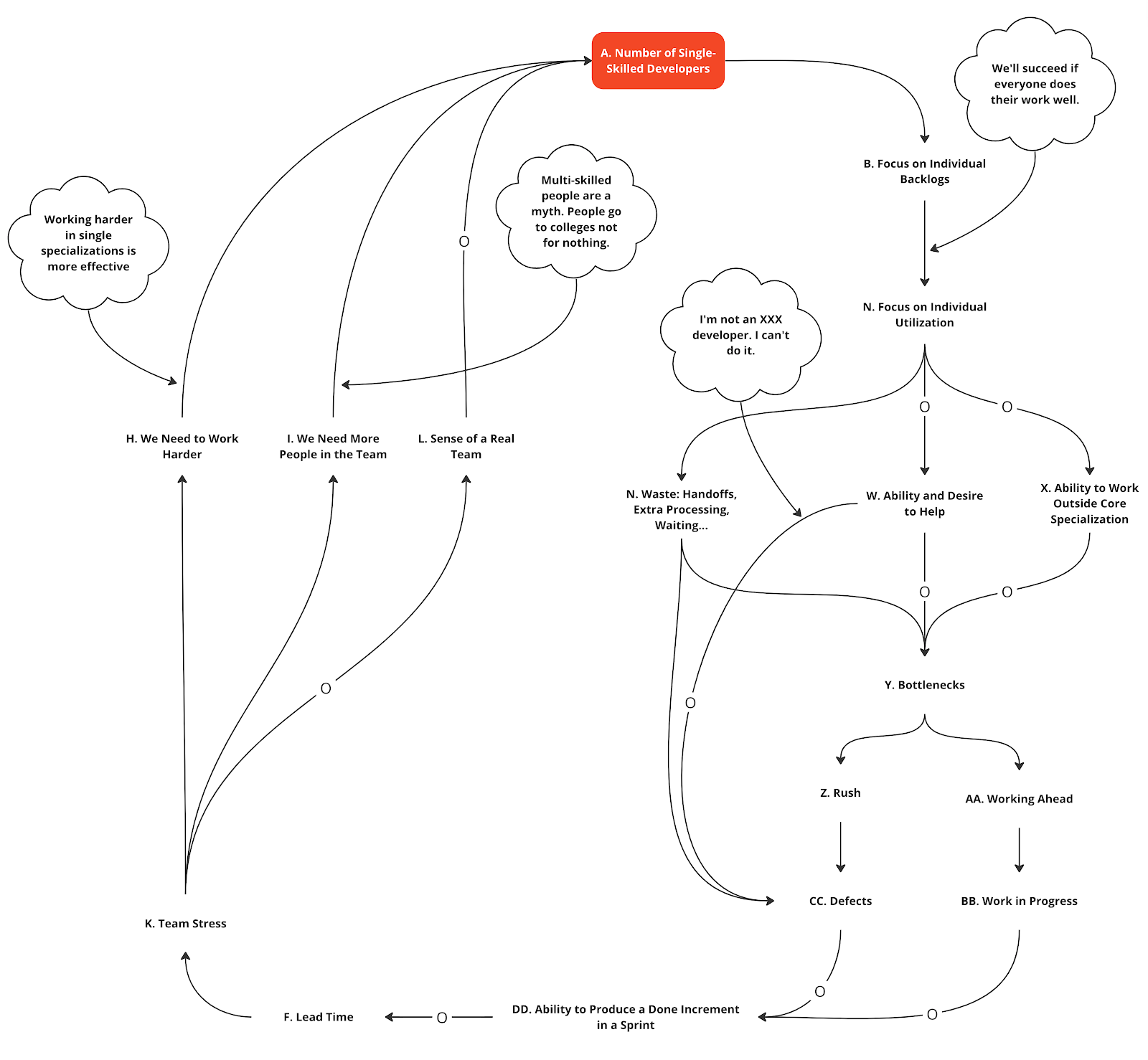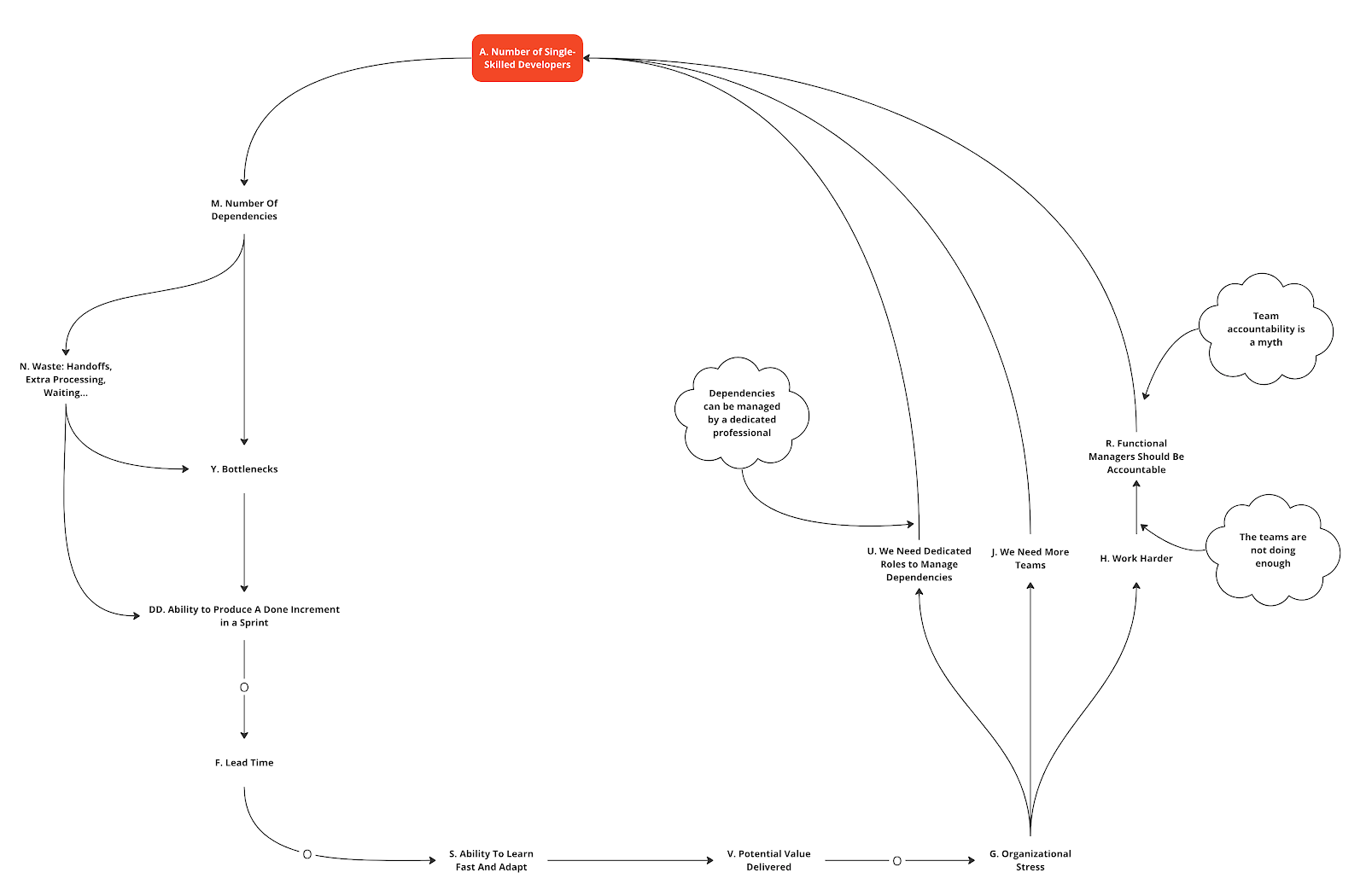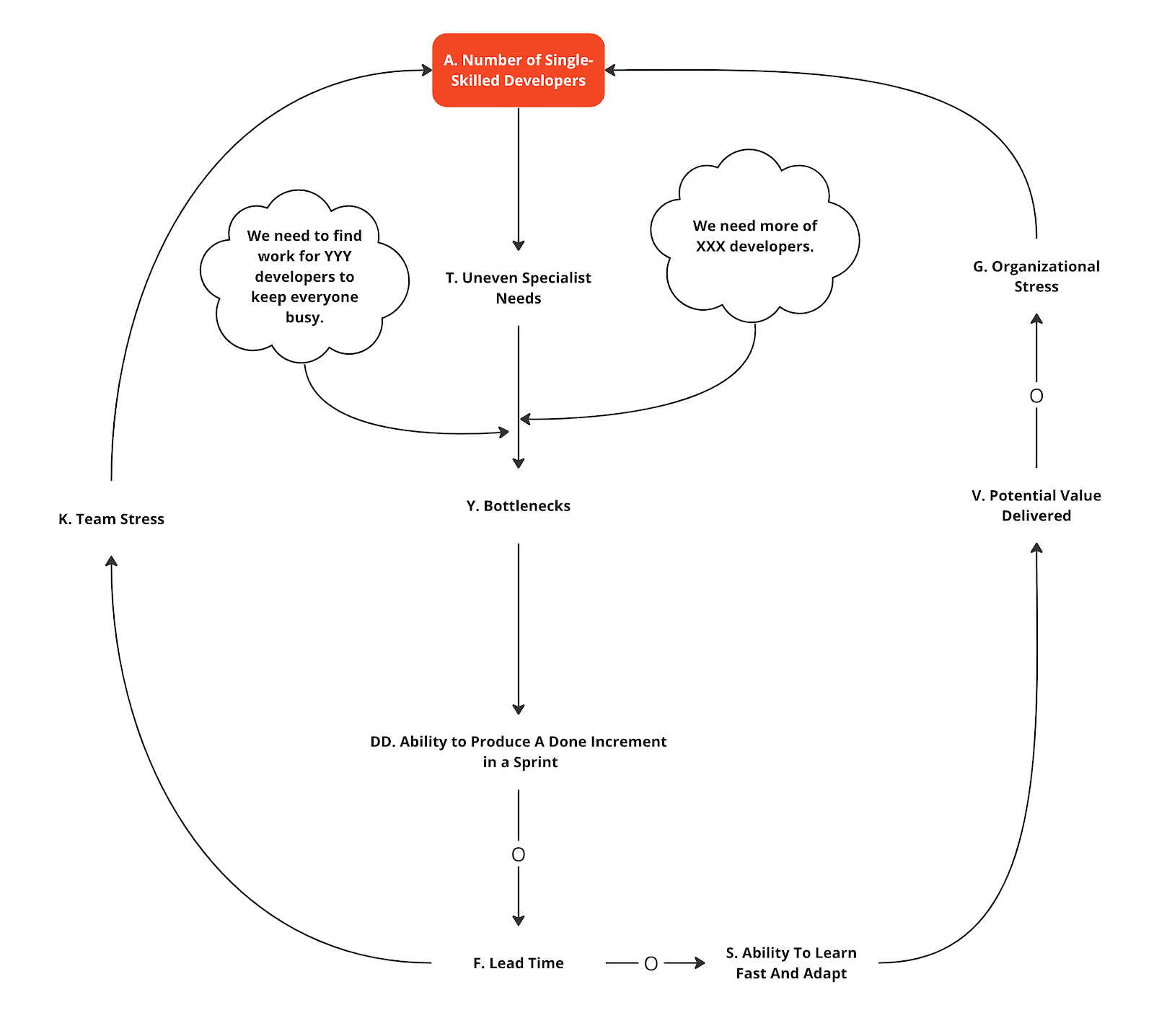Part 3: Unleash Your Scrum with Multi-Skilled Professionals - Exploring The Single-Skilled Dynamics
Welcome to Part 3 of “Unleash Your Scrum with Multi-Skilled Professionals.” In this series, we delve into the transformative power of multi-skilled learning within Scrum teams.
While many organizations proudly wave the Scrum banner, a closer examination often uncovers a mere facade. Beneath this veneer lies a persistent adherence to old structures and policies, with functional managers at the helm, championing the merits of specialization. Such an environment, driven by individual-centric metrics and rewards, inadvertently creates silos of expertise. Rather than a unified force working towards a shared goal, we witness fragmented teams, each confined to its niche.
This chapter peels back the layers of traditional organizational structures to uncover the hidden dynamics that often hinder true Agility.
To dissect these complex dynamics, I utilize the Causal Loop Diagram (CLD), a tool that excels in making visible the systemic interactions and feedback loops that conventional analysis often misses. Inspired by the work of Cesário Oliveira Ramos and Ilia Pavlichenko in “Creating Agile Organizations,” I blend their insights with my own experiences to enrich the analysis. Their examination of multifunctional learning and agility provides a sturdy foundation for understanding the systemic effects of entrenched practices.
If you’re joining me for the first time, I recommend reading the previous parts for context:
Part 1: Unleash Your Scrum with Multi-Skilled Professionals — The History and Background
Let’s dive into single-skilled dynamics and discover how they impact Scrum teams and the broader organization.
Chapter 5
The Single-Skilled Dynamics
Central to the CLD is the concept of “Single-Skilled Developers.” This element not only highlights the prevailing emphasis on specialization but also serves as the linchpin for a myriad of interconnected dynamics that ripple throughout the organization.
The complexity of the CLD warrants a segmented examination. This approach allows for a more digestible exploration, ensuring that each facet of the CLD is given its due attention. As we navigate through these subsections, you’ll gain a comprehensive understanding of how seemingly isolated decisions and policies can collectively shape the broader organizational landscape.
The Rise of Individualism
An increase in the Number of Single-Skilled Developers (A) naturally leads to a heightened Focus on Individual Backlogs (B). Being a specialist in a particular domain, each developer tends to concentrate on tasks specific to their expertise.
The Illusion of Efficiency
This focus on individual tasks and backlogs amplifies the Focus on Individual Utilization (N). The more a developer is occupied with tasks specific to their domain, the less inclined they are to venture outside their core specialization, thereby reducing their Ability To Work Outside Core Specialization (X) and diminishing their Ability and Desire to Help (W) others outside their domain. When developers are less willing or able to assist colleagues or work outside their specialization, it creates a narrow approach to task completion, leading to potential bottlenecks.
The Bottleneck Dilemma
A reduced ability to work outside one’s core area and a diminished desire to assist colleagues lead to Bottlenecks (Y) in the workflow. Tasks that require multi-disciplinary skills or cooperation get stalled, awaiting the attention of a specific specialist.
The Domino Effect
These bottlenecks have cascading effects. They lead to Rush (Z) in particular project phases, increasing the number of Defects (CC). Bottlenecks also result in Waste (D) (Waiting for tasks to be completed) and prompt team members to Work Ahead (AA) of the current tasks, increasing the Work in Progress (BB).
The Struggle for Completion
An accumulation of defects, prolonged waiting times, and an inflated work in progress adversely impact the team’s Ability To Produce a Done Increment in a Sprint (DD). This inability further elongates the Lead Time (F) required to produce potential value.
The Stress Spiral
Extended lead times induce Team Stress (K). This stress erodes the Sense of a Real Team (L), as team members might feel isolated in their silos of expertise. The stress also triggers reactions like the belief that We Need More People in the Team (I). However, instead of diversifying skills, this often leads to adding more Single-Skilled Developers, further enlarging the team but not necessarily enhancing its versatility.
The dynamic also generates the push to Work Harder (H) as a natural reaction to the mounting stress. However, this doesn’t mean working more collaboratively or diversifying skills. Instead, developers double down on their specializations, working harder within their specific domains.
The Illusion of Inadequacy
A strong Focus On Individual Utilization (N) can inversely affect the team’s Perception Of The Skill Gap that exists and hampers the ability to Deliver What Is Really Needed (O). When individuals are constantly pushed to maximize their utilization within their specialization, they might feel inadequate and lack the Ability To Work Outside Core Specialization (X). This perception can be misleading, as it’s often based on the pressure to always be “productive” in one’s specialization rather than a genuine skill deficiency.
The Learning Paradox
This perceived skill gap diminishes the Ability And Desire To Learn (P). If developers believe they’re already lagging in their core domain, they might be reluctant to invest time in expanding their skill set. This reluctance, in turn, reinforces the cycle, increasing the Number of Single-Skilled Developers (A). The more developers stick to their niches, the fewer multi-skilled individuals in the team.
Flexibility Fuels Adaptability
On the flip side, a genuine Ability And Desire To Learn (P) fosters Team Flexibility (Q). Teams with a mix of skills can adapt to changing requirements more easily. They can pivot based on the task at hand rather than being constrained by their specializations. This flexibility enhances the team’s Ability To Learn Fast And Adapt (S), making them more agile and responsive. This adaptability is crucial for delivering Potential Value Delivered (V) and reducing Organizational Stress (G).
The Dependency Dilemma
Specialized Teams and the Number of Single-Skilled Developers (A) naturally lead to a rise in the Number of Dependencies (M). Each team and each specialist might rely on others to complete interconnected tasks.
The Handoff Hurdle and the Extra-Processing Snare
A pronounced Number of Dependencies (M) often culminates in increased Waste (N) due to Handoffs between teams and team members, Extra-Processing from navigating artificial hoops during interactions, and Waiting.
A backend developer might complete their part of a feature and then “hand it off” to a frontend developer or a tester. Each Handoff introduces potential delays and miscommunications. It’s akin to passing a baton in a relay race; there’s always a risk of dropping it or slowing down during the exchange.
Another manifestation of this dynamic is the expectation for detailed specifications. Analysts or designers might be tasked with crafting exhaustive specifications that cover all intricacies, anticipating every nuance and potential challenge. This is a tall order for any single individual. The reality is that creating a “perfect” specification that foresees every detail is a Herculean, if not impossible, task.
The consequence? Specifications travel back and forth between teams and team members, undergoing multiple refinements as the feature development progresses. This can be a significant source of Extra Processing and Waiting.
Moreover, it can breed tension among team members. Developers might feel they’re working with shifting goalposts, while analysts and designers might feel undue pressure to produce flawless specifications from the outset.
The team’s potential misdiagnosis of the problem is a frequent fallout of this dynamic. They might erroneously conclude that the solution lies in learning to draft “perfect” specifications; this pushes the onus onto analysts and designers, perpetuating the evil cycle.
Extra Processing may manifest as additional checks, validations, or even rework when integrating different feature parts. When each team member works in isolation, focusing solely on their individual tasks, they might not have a holistic view of the entire feature. This can lead to redundant work or tasks that must be redone to fit together seamlessly.
Dependencies (M) and the Process Waste (N) they generate negatively impact the Ability to Produce A Done Increment In A Sprint (DD). These factors can derail the team’s progress, making it challenging to achieve the Sprint Goal. Happening sprint after sprint, the dynamic, as previously discussed, extends the Lead Time (F).
The Learning Lag
Extended Lead Time (F) inversely affects the team’s Ability To Learn Fast And Adapt (S). Longer cycles mean feedback is delayed, and the team’s ability to iterate and improve is hampered. This sluggishness reduces the Potential Value Delivered (V) to the organization, leading to Organizational Stress (G).
Organizational Reactions and Their Pitfalls
The Organizational Stress (G) stemming from reduced value delivery triggers several reactions.
The Push to Specialize Further: One reaction is the push to Work Harder (H), which, as we’ve seen, drives developers to specialize further, exacerbating the problem. The management, in turn, calls for more Accountability on the part of Functional Managers (R). In their bid to optimize their domain’s output, these managers might turn to more micro-management and inadvertently bolster the Number of Single-Skilled Developers (A), believing that more control and specialists can address the challenges, reinforcing the cycle.
The Dependency Management Misstep: Another reaction is the belief that We Need Separate Roles to Manage Dependencies (U). Instead of addressing the root cause — over-specialization — organizations might introduce roles like “dependency managers” or “integration specialists.” While this might seem like a solution, it often adds another layer of single-skilled specialists, increasing the Number of Single-Skilled Developers (A).
The Team Expansion Trap: Similarly, the idea that We Need More Teams (J) is a knee-jerk response to the challenges. However, adding more teams without addressing the core over-specialization issue means these new teams are likely filled with more Single-Skilled Developers (A).
Specialist Demand Fluctuations
When teams start working from a single Product Backlog and genuinely focus on what’s important, they first order features that deliver the most value to the end-users and the business. This ordering ensures that the teams constantly work on the most impactful changes.
However, this focus can lead to Uneven Specialist Needs (T). For instance, one Sprint might focus heavily on developing a new user interface, requiring more frontend developers, while another might be centered around database optimization, needing more backend expertise. This uneven distribution can lead to certain specialists being in high demand during specific Sprints.
The Bottleneck Conundrum
As discussed earlier, Uneven Specialist Needs (T) can lead to Bottlenecks (Y). When there’s a high demand for a particular skill set and not enough team members with that expertise, tasks get queued up, waiting for the specialists to address them. These bottlenecks, as previously mentioned, can have cascading effects, leading to increased Lead Time (F), Team Stress (K), and Organizational Stress (G). These effects, in turn, trigger the associated reactions we discussed earlier, reinforcing the cycle.
Our detailed analysis of the single-skilled paradigm illuminated the complex dynamics and their ripple effects across various organizational aspects crucial for overall performance. This understanding equips us with the insight needed to craft systemic interventions carefully. By making these dynamics transparent and inspecting them closely, we are now in a position to adapt effectively, much in the spirit of Scrum’s empirical approach of “inspect and adapt.”
Drawing from the insights in ‘Creating Agile Organizations,’ we identify several critical interventions to counteract these entrenched patterns:
Remove a Variable: Targeting a specific element in the negative loop to disrupt and ultimately break it.
Introduce a Balancing Loop: Implementing countermeasures to weaken and balance the negative reinforcing loop.
Incorporate New External Variables: Introducing new goals and metrics that align with desired performance outcomes.
Minimize Delays in Interactions: Streamlining processes to reduce lag and enhance responsiveness.
Visualizing the intricate dynamics at play makes it evident that the variable of single-skilled specialists holds a pivotal role in the system. This realization aligns with our first intervention strategy: to either weaken or remove this central variable altogether. Its profound influence over numerous systemic factors makes it a critical focal point for our efforts. Addressing this essential element can radically transform the entire system, reshaping the performance dynamics and driving significant organizational change.
As we explore strategies to transform our organizational dynamics, the insights from Chapter 7, “Unlocking a Trove of Benefits With The Multi-Skilled Paradigm,” become particularly valuable by providing a rich set of new external variables. These variables, derived from the advantages of a multi-skilled paradigm, can be strategically incorporated as performance goals.
The practical experiments embedded within the Influence Change Model from the upcoming Chapter 10 are actionable tools that can be systematically applied across different levels of our organization — from individual teams to entire product groups and the broader organizational structure — to implement the interventions we’ve discussed, whether it’s weakening or removing a central variable, introducing balancing loops, or incorporating new performance goals. By applying these experiments, we can directly influence the key elements we’ve explored in this part of the series, driving substantial improvements in the overall performance of our system.
References
Cesário Oliveira Ramos, Ilia Pavlichenko. Creating Agile Organizations. A Systemic Approach (Addison-Wesley, 2023)
Joseph Grenny, Kerry Patterson, David Maxfield, Ron McMillan, Al Switzler. Influencer. The New Science of Leading Change (McGraw Hill Education, 2013)
Craig Larman, Bas Vodde. Scaling Lean & Agile Development. Thinking and Organizational Tools for Large-Scale Scrum (Addison-Wesley, 2009)
Craig Larman, Bas Vodde. Practices for Scaling Lean & Agile Development. Large, Multisite, and Offshore Product Development with Large-Scale Scrum (Addison-Wesley, 2010)



